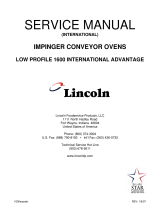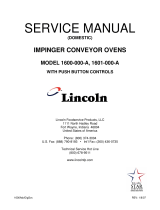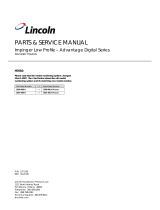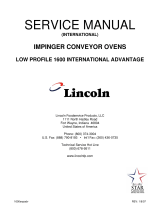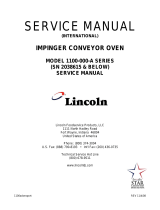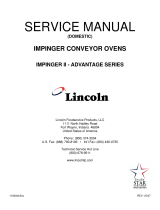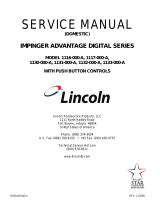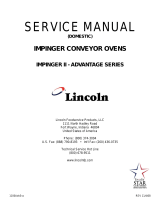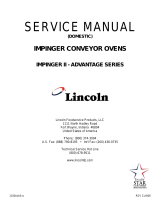Page is loading ...

1600advsvc REV: 1/8/07
SERVICE MANUAL
(DOMESTIC)
IMPINGER CONVEYOR OVENS
LOW PROFILE 1600 SERIES ADVANTAGE
Lincoln Foodservice Products, LLC
1111 North Hadley Road
Fort Wayne, Indiana 46804
United States of America
Phone : (800) 374-3004
U.S. Fax: (888) 790-8193 • Int’l Fax: (260) 436-0735
Technical Service Hot Line
(800) 678-9511
www.lincolnfp.com

Low Profile – 1600-000-A Advantage Series Service Manual – Domestic
2
TABLE OF CONTENTS
TABLE OF CONTENTS..............................................................................................................................................2
SEQUENCE OF OPERATIONS / 1600-000-A , 1601-000-A.....................................................................................3
TROUBLESHOOTING GUIDE...................................................................................................................................4
SCHEMATIC / 1600-000-A, 1601-000-A..................................................................................................................10
REMOVAL, INSTALLATION & ADJUSTMENTS .....................................................................................................11
PARTS / GENERAL - 1600-000-A ADVANTAGE SERIES......................................................................................18
BLOW UP / GENERAL – 1600-000-A ADVANTAGE SERIES ................................................................................19
PARTS / CONTROL BOX, RIGHT - 1600-000-A, 1601-000-A ................................................................................20
BLOW UP / CONTROL BOX, RIGHT - 1600-000-A, 1601-000-A ...........................................................................21
PARTS / CONTROL BOX, LEFT - 1600-000-A, 1601-000-A...................................................................................22
BLOW UP / CONTROL BOX, LEFT - 1600-000-A, 1601-000-A..............................................................................23
PARTS / OVEN BACK - 1600-000-A - SERIES .......................................................................................................24
BLOW UP / OVEN BACK - 1600-000-A - SERIES ..................................................................................................25
PARTS / CONVEYOR - 1600-000-A - SERIES .......................................................................................................26
BLOW UP / CONVEYOR - 1600-000-A - SERIES...................................................................................................27

Low Profile – 1600-000-A Advantage Series Service Manual – Domestic
3
SEQUENCE OF OPERATIONS / 1600-000-A, 1601-000-A
MODEL 1600-000-A / 120 VAC / 60 HZ / NATURAL GAS
MODEL 1601-000-A / 120 VAC / 60 HZ / L.P. GAS
POWER SUPPLY Electrical power to be supplied to the oven by a three conductor cordset. Voltage from
the black conductor to the white conductor to be 120 VAC.
White conductor is Neutral.
Green conductor is Ground.
CONTROL BOX
AUTO COOL DOWN
When the temperature in either one of the Control Boxes reaches 120°F ± 3°F (49°C
± 1.7°C), the Cooling Fan Thermostats will switch power to the Cooling Fans. The
thermostats will interrupt power to the Cooling Fans when the temperature falls to
100°F ± 3°F (37°C ± 1.7°C).
MAIN FAN CIRCUIT 120 VAC is permanently supplied to the normally open double pole power switch, a
normally open contact of the oven power relay and the normally open cooling fan
thermostats. Closing the power switch supplies 120 VAC, through the 3 A cooling fan
fuse, through both control box hi-limit thermostats to the coil of the oven power relay.
These normally open contacts now close supplying 120 VAC, through the 10A main
fan fuse to the 2 main fan motors and the 2 burner motors. Power is also supplied to
the cooling fans, the heat and conveyor control systems.
BURNER CIRCUIT Closing the Oven Power Relay supplies 120 VAC to the (2) burner Systems
NOTE: This oven utilizes (2) complete Burner/Temp. Control systems. The sequence
of operations is the same for each system.120 VAC is supplied, through the
Centrifugal Switch of the Main Fan Motor (this switch closes when the Main Fan
reaches approximately 1600 R.P.M.) through the 10 Amp Fuse, to the Ignition
Control, the Electronic Temperature Control, and the burner transformer. As the
Burner Blower reaches approximately 1600 R.P.M., its internal centrifugal switch will
close, supplying 24 VAC to the ignition control. The Ignition Control operates on both
24 VAC and 120 VAC. When the control is energized by 24 VAC, 120 VAC is
switched to the Hot Surface Igniter for 45 seconds for Hot Surface Igniter warm up.
The igniter glows red, 24 VAC is switched to the gas valve which opens, and ignition
should now occur. If ignition does not occur in 6 seconds, the control will lock out. To
recycle after lockout, turn off the burner switch for 45 seconds and then turn the
switch back on.
TEMPERATURE
CONTROL
When the Centrifugal Switch of the Main Fan Motor closes, power is applied to the
Temperature Control. The1K ohm Temperature Pot is adjusted to desired
temperature. Thermocouple will provide varying millivolts to the Temperature
Controller. The Temperature Controller supplies 120 VAC to the solenoid valve at
intermittent intervals to maintain desired temperature. The heat lamp is energized
with the solenoid valve.
CONVEYOR DRIVE Closing the on/off switch supplies 120 VAC through the oven power relay to the motor
control board. AC volts are converted to DC volts and are supplied to the conveyor
motor at terminals A+ and A-.Adjustments of the speed control potentiometer will
change resistance at terminals P1 and P2 varying the DC voltage to the motor. The
speed of the conveyor motor will increase or decrease as the DC voltage from the
board increases or decreases respectively.
NOTE: The conveyor control uses a sensor and magnet, mounted on the conveyor motor that
senses the motor speed. Any change in motor load, (±RPM) is detected by the
sensor and the voltage to the motor is adjusted accordingly.
TEMPERATURE
DISPLAY
Closing the switch supplies 120 VAC to the primary of the temperature display
transformer. The secondary of this transformer supplies 12 VAC to the temperature
display. The thermocouple supplies D.C. millivolts to the temperature display. The
display converts this millivolt reading to a temperature reading.

Low Profile – 1600-000-A Advantage Series Service Manual – Domestic
4
TROUBLESHOOTING GUIDE
GAS OVENS
MODEL 1600-000-A / NATURAL GAS / 120 VAC / 60 HZ / 1 PHASE
MODEL 1601-000-A / L.P. GAS / 120 VAC / 60 HZ / 1 PHASE
NOTE: When checking components on left side of unit, be sure to check for proper connections in power
connector, (marked P. C. on Schematic Diagram.) located inside motor cover.
SYMPTOM POSSIBLE CAUSE EVALUATION
Incoming Power
Supply
Check breakers, reset if required. Check power plug to be sure
it is firmly in receptacle. Measure the incoming power/call
power company if needed.
Main Fan Switch Check continuity between switch terminals.
Fuse, 10 Amp Check, replace if necessary.
Fuse Holder Check, replace if necessary.
Fuse 3A Check, replace if necessary.
Fuse holder Check, replace if necessary.
Hi Limit Thermostat(s)
Control Box
Check for voltage on both sides of the switch. Terminals are
normally closed. If open, reset and test oven for proper
operation. If thermostat will not hold and control box
temperature is not exceeding 140°F (60°C), replace
thermostat.
Oven Power Relay Check for 120 VAC to the relay coil. If voltage is not present,
trace wiring back to the control box hi-limit. If voltage is
present, check to insure contacts are closing. Check for 120
VAC supplied to terminal #2 of the relay.
Main Fan Motor Check for opens, shorts, or grounds. WITH POWER OFF turn
fan blade to check for locked rotor.
Oven fan will not run
Capacitor Check for shorts or grounds.
WARNING: Capacitor has a stored charge, discharge before
testing.
Incoming Power Check main circuit breakers, reset if required, call power
company if needed.
Main Fan Switch Check continuity between switch terminals
Fuse 3 amp. Check, replace if necessary.
Fuse Holder Check, replace if necessary.
Hi Limit Thermostat(s)
Control Box
Check for voltage on both sides of the switch. Terminals are
normally closed. If open, reset and test oven for proper
operation. If thermostat will not hold and control box
temperature is not exceeding 140°F (60°C), replace
thermostat.
No control box cooling
Cooling Fan(s) 120 VAC should now be at the fan motor. If voltage is present,
check motors for shorts or opens. WITH POWER OFF:
Check for locked rotor.
Incoming Power
Supply
Check circuit breakers, reset if required. Call the power
company if needed.
Cooling Fan
Thermostat(s)
Check the cooling fan thermostat. (Thermostat closes at
120°F and opens at 100°F). With the cooling fan thermostat
preheated, check for continuity. If switch is open, replace.
Fuse, 3 amp Check, replace if necessary
Fuse Holder Check, replace if necessary
No automatic control
box cooling
Hi Limit Thermostat(s)
Control Box
Check for voltage on both sides of the switch. Terminals are
normally closed. If open, reset and test oven for proper
operation. If thermostat will not hold and control box
temperature is not exceeding 140°F (60°C), replace
thermostat.

Low Profile – 1600-000-A Advantage Series Service Manual – Domestic
5
Cooling Fan(s) 120 VAC should be at the motor. If voltage is present, check
motor for shorts, opens, or grounds. WITH POWER OFF:
check for locked rotor.
Gas Supply Check for adequate gas supply and closed manual gas valves.
Also, check flexible gas line connection.
Main Fan If not operating, refer to "Oven fan will not run".
Oven will not heat
NOTE: These ovens utilize 2 complete burner/temperature control systems. Each system will follow the same
troubleshooting sequence.
Centrifugal Switch of
Main Fan Motor
Check for 120 VAC supplied to the centrifugal switch, if
voltage is not present, trace the wiring back to the oven power
relay. Check for 120 VAC out of the centrifugal switch. If
voltage is supplied to the centrifugal switch, and motor is
running, but there is no voltage out of the centrifugal switch,
replace the fan motor.
(NOTE: See Schematic Diagram of proper wire numbers on
motors.)
Fuse, Burner 10A Check, replace if necessary.
Fuse holder Check, replace if necessary
Burner Blower Motor Check for 120 VAC supply to the burner blower motor, if 120
VAC is present and motor does not turn, replace the motor.
Burner Transformer Check for 120 VAC to primary of the 24 VAC burner
transformer. If voltage is not present, trace wiring back to the
fuse. If voltage is present, check for 24 VAC at the secondary,
if no secondary voltage is present, replace the transformer.
Centrifugal Switch of
Burner Blower Motor
Check for 24 VAC supply to the centrifugal switch of burner
blower motor (see Schematic for proper wire numbers). If no
voltage is present, trace wiring back to the transformer. If
voltage is present, check for 24 VAC at the output of the
centrifugal switch. If there is no output, and the burner blower
motor is running, replace the burner blower motor.
Ignition Control Check for 24 VAC supply to the ignition control at terminals
marked 24V and 24Vgnd. If voltage is not present, trace
wiring back to the centrifugal switch. Check for 120VAC
supply to the ignition control at terminals L1 and L2. If no
voltage is present, trace wiring back to fuse. If the above
checks are okay, proceed. The ignition control should switch
120VAC to the hot surface igniter, across the (2) terminals
marked HIS. If no voltage is present, replace the ignition
control.
Hot Surface Igniter
(Located inside Burner
Assy)
If 120 VAC is present at HSI terminals, visually check to see
that the hot surface igniter is heating (igniter may be viewed
through port glass in end of burner tube). The igniter should
glow bright red. Check all connections to be sure they are
tight. If the igniter does not heat, replace.
Ignition Control After 45 seconds of hot surface igniter pre-heat, the ignition
control will switch 24 VAC to the gas control valves. Check for
24 VAC output from the ignition control, and across terminals
marked "valve" and "valve gnd". If no voltage is present,
replace the ignition control.
NOTE: The ignition control contains a safety lockout circuit. If
a flame is not detected within 6 seconds after the gas control
valve is energized, the ignition control will lockout. To reset,
turn the power switch "off", wait 45 seconds and switch the
system "on" to retry ignition.
Gas Control Valves Check for 24 VAC supplied to the gas control valves. If
voltage is present, the valves should open. Check for gas
pressure at the pressure tap, located in the gas piping just
prior to the burner. If there is no gas pressure, and the voltage
is supplied to valves, check piping for obstructions. If there

Low Profile – 1600-000-A Advantage Series Service Manual – Domestic
6
are no obstructions, replace gas control valves.
Hot Surface Igniter The ignition control will keep the gas control valves energized
for 6 seconds. At the end of 6 seconds, the hot surface igniter
must sense a flame, or, the ignition control will go into lockout.
(The ignition control requires a minimum of 0.8 microamps
D.C.) To check the flame sensing operation, connect a digital
multimeter (capable of measuring D.C. micro-amps) between
the "ground" terminal on ignition control and the ground lead.
NOTE: This is a current measurement and the meter must be
connected in series. If these readings are not achieved, check
bypass orifice for obstructions, if bypass orifice is clear,
replace the hot surface igniter.
NOTE: The D.C. micro amp test must be conducted with the
oven in low flame (bypass) operation. Turn the temperature
control to its lowest setting.
Power Supply If there is sufficient micro-amp current, but the flame will not
stay lit, check for proper polarity of the 120 VAC power supply
Ignition Control If there is sufficient micro-amp current, and the 120 VAC
polarity is correct, but the flame will not stay lit, replace the
ignition control.
NOTE: Check for proper ground connection of the ignition
control.
Flame will not stay lit
NOTE: Flame should
be lit at this time.
Temperature Control Check for 120 VAC at terminal #7 to neutral on temperature
control. If no voltage, trace voltage back to fuse holder. Turn
the temperature adjustment knob to maximum temperature
position and check for 120 VAC at the load terminal #8 and
neutral. If 120 VAC is present and unit is not heating, refer to
"Temperature Solenoid Valve" for next check. If 120 VAC is
not present, proceed.
Thermocouple Probe WITH POWER ON AND THERMOCOUPLE LEADS
ATTACHED TO THE TEMPERATURE CONTROL BOARD:
Measure the D.C. millivolt output of these leads. Refer to
thermocouple chart on page 17 for proper readings. If these
readings are not achieved, replace the thermocouple.
Temperature Set
Potentiometer
Disconnect the potentiometer leads Disconnect the pot from
the board. Place ohm meter test leads on the blue and green
pot leads. Reading should be 1 K ohms. Place meter leads
across the blue and purple pot leads and rotate knob from high
to low. Repeat on green and purple leads. Check for even
rise and fall of ohms reading to insure that there are no open
or dead spots in the potentiometer. Check each lead to
ground for shorts. Replace pot if it does not meet the above
test
Low flame is on, but
no main flame
Temperature Solenoid
Valve
If 120 VAC is present on the temperature control board at load
terminal #8 to neutral, check for voltage at temperature
regulation valve. If voltage is present, listen for valve to open
and close. Also check for opens or shorts in the coil. Replace
as necessary.

Low Profile – 1600-000-A Advantage Series Service Manual – Domestic
7
Intermittent Heating Thermal/Overload of
Main Fan and Burner
Blower Motors
The main fan motors and the burner blower motors are
equipped with internal thermal protection and will cease to
operate if overheating occurs. As the motors overheat and
then cool, this will cause the units to cycle on and off
intermittently. Improper ventilation or preventive maintenance
may cause this. Also, most of the problems listed under
"Oven will not heat" can cause intermittent failure.
Voltage Supply Check incoming voltage supply at line 1 to neutral. There
should be a voltage reading of 120 VAC. If not present, check
breakers.
Fan Switch See procedure for checking at beginning of section.
Conveyor will not run
10 Amp Fuse Check and/or replace.
Fuse holder Check and/or replace.
Speed Adjustment
Potentiometer
This is a 0 to 10 K ohm, 1 turn potentiometer. With power off,
remove the black and white pot leads from the motor control
board at terminals P1, P2. Place the meter leads on the black
lead (P2) and on the white lead (P1). Rotating the pot., slowly,
from low to high, the meter readings should show an even
transition from 0 to 10 K ohms ± 5%. There should be no
dead or open spots through out the 1 turn of the pot. Check
both leads to ground. There should be no continuity to
ground. If any of the above checks fail, replace the pot
DC Motor Control
Board
Check for 120 VAC input to the control board at terminals L1
and L2. If not present, check wiring back to the fuse. If 120
VAC is present at L1 and L2, check both fuses on control
board (8A line and 1A armature), check the VDC output at
terminals A+ and A-. If 120 VAC is present at terminals L1
and L2, and DC voltage is present A+ and A-, but motor does
not run, check gear motor as follows.
Conveyor Gear Motor If DC voltage is present at A+ and A- and the motor does not
run, first check the mini breaker and then the conveyor. Refer
to the next possible cause. Check the leads to the motor for
evidence of any shorts or opens, and each lead to ground.
Check motor brushes. From the top of the motor, rotate motor
shaft to determine if there is a locked rotor or a locked gear
box (use care so magnet and H.S. board are not damaged).
Replace motor as needed.
Conveyor Check for any mechanical misalignment. Also, check for worn
bearings. A conveyor belt that is over tightened will cause
excessive bearing wear and sometimes, irregular speed.

Low Profile – 1600-000-A Advantage Series Service Manual – Domestic
8
Power Supply Check power supply at the DC control board for the 120 VAC
at board terminals L1 and L2.
Motor Control Board Place the test meter probes on terminals A+ and A-. (With
speed potentiometer set to maximum speed (Approximately 2
min.) The meter reading should be approximately 100 VDC
(±3%), if voltage is not steady within limits, then the board is
probably bad. Always check the speed pot., be sure it is okay
before changing a board. This test is not always 100%
accurate as this test is not performed at operating speeds.
However, this test is the best method currently available.
DC Gearmotor If the DC control board is steady then the problem may be the
motor or gearbox. Check the brushes in the motor for
excessive arching and/or unusual wear. Check the motor and
gearbox from instruction located under "possible cause" listing
"conveyor gear motor."
Magnet Check to insure that the magnet (cemented to shaft of
conveyor drive motor) has not been damaged, or come loose
from motor shaft. Replace as needed.
Conveyor speed
varying or intermittent
Hall Effect Sensor Check for any physical damage to hall effect sensor (mounted
on conveyor drive motor.) Check all wiring and connections
for damage. Check all connections for tightness or proper
location. Replace as needed. Connect new hall effect to
system and check for steady operation.

Low Profile – 1600-000-A Advantage Series Service Manual – Domestic
9
Display Transformer Measure the transformer primary for a nominal 120 VAC input,
if voltage is not present, trace wiring back to the oven power
source. Measure the secondary output, which will normally be
12-15 VAC. Voltage across terminals 1 and 3 on the temp.
display should read 12-15 VAC. Terminals 1-2 and 2-3 should
be 1/2 the voltage reading to 1-3. If the above secondary
readings are not achieved, replace transformer.
Temp. display
inoperative
Temp. Display If proper voltage is present at terminals 1, 2, and 3 on
temperature display, but the display is not lighted, recheck all
connections for tightness. If temperature display is still not
operating, replace the temperature display.
Temp. Display
inaccurate, erratic or
inoperative
Thermocouple Connect the thermocouple of a pyrometer to the thermocouple
on the temperature control board. (Be sure to maintain proper
polarity of thermocouple leads--see Adjustment Section for
proper procedure.) The pyrometer will indicate oven
temperature. Measure DC millivolts of thermocouple at the
temperature display. See thermocouple chart in adjustment
section for proper readings. Replace thermocouple if proper
readings are not achieved. If readings are correct on the
thermocouple, replace temperature display.

Low Profile – 1600-000-A Advantage Series Service Manual – Domestic
10
SCHEMATIC / 1600-000-A, 1601-000-A

Low Profile – 1600-000-A Advantage Series Service Manual – Domestic
11
REMOVAL, INSTALLATION & ADJUSTMENTS
MODEL SERIES 1600 ADVANTAGE
CAUTION !
BEFORE REMOVING OR INSTALLING ANY COMPONENT IN THE IMPINGER
OVEN BE SURE TO DISCONNECT ELECTRICAL POWER AND GAS SUPPLY
BURNER CONTROL - HONEYWELL - REPLACEMENT
A. Remove appropriate control box cover.
B. Remove wires from control, note wire number and location for re-assembly.
C. Remove four (4) screws from control and replace.
D. Reassemble in reverse order and check system operation.
BURNER BLOWER MOTOR - REPLACEMENT
A. Remove appropriate control box cover.
B. Unplug motor connector.
C. Remove three (3) screws from blower tube at burner housing.
D. Remove air shutter assy. from old motor for installation on new motor assy.
E. Reassemble in reverse order and check system operation.
NOTE: CHECK AIR SHUTTER ADJUSTMENT- should be set at 1/2 open.
HOT SURFACE IGNITER - REPLACEMENT
A. Remove appropriate control box cover.
B. Disconnect gas line at union.
C. Remove four (4) nuts from burner orifice bracket.
D. Remove tube for bypass flame.
E. Unplug connector at burner housing.
F. Remove three (3) screws from burner housing end cap and remove
hot surface igniter and burner tube assy.
G. Replace igniter assembly and reassemble in reverse order. CAUTION:
USE CARE NOT TO DAMAGE NEW IGNITER.
NOTE: Check all gas line fittings for leaks. Make sure connector is seated properly.
BURNER INDICATOR LIGHT (GAS) - REPLACEMENT
A. Remove control box cover
B. Remove two (2) wires from light housing.
C. Slide light housing sideways to remove.
D. Reassemble in reverse order and check system operation.
CONVEYOR CONTROL POTENTIOMETER (10K OHM) - REPLACEMENT
A. Remove control box cover
B. Loosen two (2) allen screws and remove knob by sliding off shaft.
C. Remove nut from potentiometer shaft and push out.
D. Unplug wire connector from conveyor control board.
E. Reassemble in reverse order and check system operation.
F. Recalibrate conveyor control board.
CONVEYOR CONTROL BOARD - REPLACEMENT
A. Shut off power at main breaker.
B. Remove control panel top and front cover.
C. Disconnect wiring (push on connectors) from control board, note proper location
of connectors for reinstallation and exchange boards on the mounting bracket
before reinstallation.

Low Profile – 1600-000-A Advantage Series Service Manual – Domestic
12
D. Reassemble in reverse order and check system operation.
CONVEYOR CONTROL BOARD - CALIBRATION
A. Connect digital volt meter to the hall effect sensor. Black meter lead connected to
black hall effect sensor lead, red meter lead to white hall effect sensor lead.
B. Turn conveyor control knob fully counter clockwise. Loosen knob and align with
calibration line and tighten knob.
C. Set knob to 2 minute setting. Adjust "max" pot on conveyor control to 219 Hz.
D. Set control knob to 20 minute setting, and adjust "min" pot on conveyor control
21.9 Hz. Recheck at 2 minute and 20 minutes until proper readings are achieved.
Seal pots with glyptol or nail polish.
CIRCUIT BREAKER
A. Shut off power at main breaker.
B. Remove control panel top and front panel.
C. Disconnect two (2) wires from circuit breaker.
D. Remove knurled mounting nut and push out.
E. Reassemble in reverse order.
NOTE: Be sure to reset breaker before operating.
CONVEYOR DRIVE MOTOR - REPLACEMENT
A. Shut off power at main breaker.
B. Remove conveyor.
C. Remove control panel top and front cover.
D. Disconnect wiring from motor and mark for reassembly.
E. Remove sprocket from motor drive shaft.
F. Remove 4 screws and remove conveyor motor and mounting bracket.
G. Remove mounting bracket from conveyor motor assembly.
H. Reassemble in reverse order.
REVERSING CONVEYOR DIRECTION
A. Shut off power at main breaker.
B. Remove control panel top.
C. Reverse wires fastened to terminals A+ and A- on conveyor control board.
(See schematic diagram for wire numbers.)
D. Reassemble in reverse order.
HALL EFFECT SENSOR - REPLACEMENT
A. Shut off power at main breaker.
B. Remove control panel top and front cover.
C. Remove conveyor motor assembly.
D. Remove wire connector from hall effect sensor board.
E. Remove two (2) screws from conveyor drive motor.
F. Remove sensor board from mounting bracket.
G. Reassemble in reverse order.
FUSEHOLDER - REPLACEMENT
A. Remove appropriate control box cover.
B. Remove two (2) wires, note wire number and location.
C. Remove mounting nut on back side of fuse holder and push out.
D. Reinstall in reverse order and check system operation.

Low Profile – 1600-000-A Advantage Series Service Manual – Domestic
13
GAS VALVE, DUAL SAFETY - REPLACEMENT
A. Remove appropriate control box cover.
B. Remove incoming gas line.
C. Remove screws from incoming nipple mounting bracket.
D. Remove incoming nipple.
E. Remove bypass tube assy.
F. Disconnect pipe union.
G. Disconnect wiring from control valve (four [4] push on connectors), make
note of wire numbers and location for reinstallation.
H. Remove gas piping from old valve and install on new one.
I. Reassemble in reverse order and check system operation. Set manifold pressure on gas valve.
Pressure should be 3.5 in W.C. Nat., 10 in W.C. L.P.
NOTE: Check all gas line fittings for leaks, check and adjust manifold pressure.
FRONT VIEW
MANIFOLD ADJUSTMENT
SCREW LOCATED UNDER
COVER SCREW
TOP VIEW
PILOT
LINE
CONNECTION
MANIFOLD PRESSURE
ADJUSTMENT CONNECTION
MANIFOLD ADJUSTMENT
SCREW LOCATED UNDER
COVER SCREW
TEMPERATURE REGULATING VALVE - REPLACEMENT
A. Remove appropriate control box cover
B. Remove bypass tube assy.
C. Remove four (4) nuts from burner orifice bracket.
D. Disconnect pipe union.
E. Disconnect two (2) wires from valve and remove assembly.
F. Remove gas piping from old valve and install on new one.
G. Reassemble in reverse order and check system operation. NOTE: Check
all gas line fittings for leaks and insure valve gas flow is in proper direction .
MAIN ORIFICE - REPLACEMENT
A. Remove appropriate control box cover.
B. Remove bypass tube assembly.
C. Remove four (4) nuts from burner orifice bracket.
D. Disconnect pipe union.

Low Profile – 1600-000-A Advantage Series Service Manual – Domestic
14
E. Remove assembly and replace main orifice.
F. Reassemble in reverse order and check system operation.
NOTE: Check all gas line fittings for leaks.
TEMPERATURE CONTROL POTENTIOMETER - REPLACEMENT
A. Remove control box cover.
B. Loosen screw and slide knob off potentiometer shaft.
C. Remove mounting nut and push out.
D. Remove three (3) wires from electronic temperature control,
note wire color and location for reinstallation.
E. Reassemble in reverse order and check system operation.
ON-OFF SWITCH (POWER) - REPLACEMENT
A. Remove control box cover.
B. Depress spring clips on side of switch and push out.
C. Remove wires from back of switch, note wire number and location.
D. Reassemble in reverse order and check system operation.
NOTE: Make sure switch housing is fully seated in control box housing.
DUAL TEMPERATURE DISPLAY - REPLACEMENT
A. Shut off power at main breaker.
B. Remove control panel top and front cover.
C. Remove all wires from temperature display and mark wires for reassembly.
D. Pry temperature display to remove from mounting tabs (this is a pressure fit).
E. Reassemble in reverse order.
CALIBRATE TEMPERATURE
A. (See ‘Temperature setting for new temperature control board’.) Set Temp. Control to 500°F.
Allow temperature to stabilize.
B. "Fine Tune" temperature setting to achieve measured temperature swings from
497°F to 503°F. When actual temperature falls between 497°F and 503°F,
the display must show 500°F.
C. Adjust temp. adj. pot on Temp Display to achieve a display reading of 500°F (260°C).
TRANSFORMER-TEMPERATURE DISPLAY - REPLACEMENT
A. Remove control box cover and front panel.
B. Remove five (5) wires (2 primary side, 3 secondary side), note color
and location of wires for reinstallation.
C. Remove two (2) screws from transformer base and replace assembly.
D. Reassemble in reverse order and check system operation.
BURNER CONTROL TRANSFORMER - REPLACEMENT
A. Remove appropriate control box cover.
B. Remove two (2) wires on primary side, note color and location.
C. Remove two (2) wires on secondary side at burner control (Honeywell).
D. Remove two (2) screws from transformer base and replace assembly.
E. Reinstall in reverse order and check system operation.
CAPACITOR, MAIN FAN MOTOR (7.5 MFD/370V) - REPLACEMENT
A. Remove appropriate control box cover.
B. Remove two (2) wires from capacitor, note wire number and location.
WARNING: Capacitor has a stored charge, discharge before handling or testing.
C. Cut two (2) tyraps securing capacitor to base and replace.
D. Reinstall in reverse order and check system operation.

Low Profile – 1600-000-A Advantage Series Service Manual – Domestic
15
RELAY - REPLACEMENT
A. Remove control box cover.
B. Remove wires from relay, note wire numbers and location for reinstallation.
C. Remove two (2) screws from relay base and replace relay.
D. Reassemble in reverse order making sure wire connectors are properly seated.
E. Check system operation.
THERMOSTAT, COOLING FAN - REPLACEMENT
A. Remove appropriate control box cover.
B. Remove two (2) wires from thermostat, note wire number and location.
C. Remove two (2) mounting screws and replace thermostat.
D. Reassemble in reverse order and check system operation.
ELECTRONIC TEMPERATURE CONTROL - REPLACEMENT
A. Remove control box cover and front panel.
B. Identify correct control and remove wires from control. Note wire number and location
for reinstallation.
C. Remove temperature control from mounting tabs.
D. Reassemble in reverse order and check system operation.
TEMPERATURE SETTING FOR NEW TEMPERATURE CONTROL BOARD
+
-
digital
thermometer
+
-
temperature
adjust pot.
thermocouple
type J
PROCEDURE FOR SETTING MAXIMUM TEMPERATURE POTENTIOMETER (P6)
NOTE: When replacing temp control, turn oven temperature control to its
maximum heat position and allow 30 minute preheat before calibrating.
Connect temperature probe to the oven thermocouple leads at the
temperature control board and adjust potentiometer to a
maximum temperature of 600°F (315°C). (See Diagram Above)
HIGH LIMIT THERMOSTAT - REPLACEMENT
A. Remove appropriate control box cover.
B. Remove two (2) wires from thermostat, note wire numbers and location for
reinstallation.
C. Remove screws from bracket and remove thermostat.
D. Reassemble in reverse order and check system operation.
NOTE: Depress reset button to insure thermostat is set for operation.

Low Profile – 1600-000-A Advantage Series Service Manual – Domestic
16
COOLING FAN MOTOR - REPLACEMENT
A. Remove appropriate control box cover.
B. Remove mounting screws.
C. Unplug electrical connector and remove fan motor assembly.
D. Reassemble in reverse order and check system operation.
MAIN FAN MOTOR - REPLACEMENT
A. Shut off gas supply and remove gas line and manifold lines from back of oven.
B. Remove screws from motor cover housing and lift off.
NOTE: When ovens are stacked, all motor cover housings are fastened together.
C. Unplug power connector .
D. Unplug thermocouple.
E. Unplug two (2) motor connectors.
F. Remove eight (8) bolts from oven back (4 left, 4 right) and lift out.
G. Remove one (1) screw from fan hub and slide fan blade off of motor shaft.
(Note location of fan blade for reinstallation).
H. Loosen lock nuts on cone. Remove two mounting bolts and remove motor from back assy.
I. Remove four (4) hex head screws from motor mount bracket.
Remove motor mount from motor and reinstall on new motor.
J. Reassemble in reverse order.
NOTE:
1. Make sure motor is centered in back housing.
2. Verify correct location of fan blade and that it is not hitting fan shroud.
3. Make sure all connectors are properly seated and making good contact.
4. When reinstalling gas manifold across back of oven, check all fittings for leaks.
K. Check system operation (allow 30 minute preheat for all checks).
NOTE: Position of the fan on the motor shaft will be 1.875" from the top of the oven
back cone to the blade spider assembly on the fan hub. (See drawing below.)
1.875 INCH
FROM CONE TO
FAN SPIDER
THERMOCOUPLE (TYPE J) - REPLACEMENT
A. Remove control box covers. Remove motor cover and remove oven back to access
thermocouple.
NOTE: Removal of oven back assy. is required to replace thermocouples.
B. Remove thermocouple from wire form in oven chamber and remove from chamber.
NOTE: R. H. Thermocouple (viewed from front) is connected directly to the
temperature control board, remove two (2) wires, make note of wire colors
(terminal #6 is White + and terminal #7 is Red-) and location for reinstallation.
When changing L.H. Thermocouple (viewed from front), the back motor cover
must also be removed to gain access to the thermocouple connector plug.
C. Reassemble in reverse order making sure bulb is placed securely
in the wire
form in the oven chamber.
D. Check system operation, recalibrate as needed. NOTE: The R.H. and L.H.
Thermocouples have different connectors on the wire ends and must be ordered
accordingly.
INFORMATION:
When two wires composed of dissimilar metals are joined together and one of the ends is
heated, a continuous current flow is generated. We use an iron constant (Type J)
thermocouple. The iron wire increases the number of dissimilar junctions in the circuit.

Low Profile – 1600-000-A Advantage Series Service Manual – Domestic
17
It is possible to check a thermocouple with a properly calibrated D.C. millivolt meter. At 32°F,
the millivolt reading should be 0.00. This can be checked by inserting the
thermocouple into an ice bath.
The millivolt reading at 72°F should be 1.134.
When using the following chart, the temperature at the terminal connections must be noted.
This temperature is called the Junction Temperature.
The following chart lists the thermocouple millivolt readings from 200°F to 600°F.
O V E N T E M P
200°F
250°F
300°F
325°F
350°F
400°F
425°F
450°F
500°F
550°F
600°F
J
90°F 3.26 4.77 6.30 7.06 7.83 9.37 10.14 10.91 12.46 14.00 15.53
U
88°F 3.32 4.83 6.36 7.12 7.89 9.43 10.20 10.97 12.51 14.05 15.59
N
86°F 3.37 4.88 6.41 7.17 7.94 9.49 10.26 11.03 12.57 14.11 15.65
C
84°F 3.43 4.94 6.47 7.23 8.00 9.54 10.31 11.09 12.63 14.19 15.71
T
82°F 3.49 5.00 6.53 7.29 8.06 9.60 10.37 11.14 12.69 14.23 15.76
I
80°F 3.55 5.06 6.59 7.35 8.12 9.66 10.43 11.20 12.74 14.28 15.82
O
78°F 3.60 5.11 6.64 7.40 8.17 9.72 10.49 11.26 12.80 14.34 15.86
N
76°F 3.66 5.17 6.70 7.46 8.23 9.77 10.55 11.32 12.86 14.40 15.94
75°F 3.69 5.20 6.73 7.49 8.26 9.80 10.57 11.35 12.89 14.43 15.97
74°F 3.72 5.23 6.76 7.52 8.29 9.83 10.60 11.37 12.92 14.46 15.99
72°F 3.78 5.29 6.82 7.58 8.35 9.89 10.66 11.43 12.97 14.51 16.05
T
70°F 3.83 5.34 6.87 7.63 8.40 9.95 10.72 11.49 13.03 14.57 16.11
E
68°F 3.89 5.40 6.93 7.69 8.46 10.00 10.78 11.55 13.09 14.63 16.17
M
66°F 3.95 5.46 6.99 7.75 8.52 10.06 10.83 11.61 13.15 14.69 16.23
P
64°F 4.01 5.52 7.05 7.81 8.58 10.12 10.89 11.66 13.20 14.74 16.28
62°F 4.06 5.57 7.10 7.86 8.63 10.18 10.95 11.72 13.26 14.80 16.34
60°F 4.12 5.63 7.16 7.92 8.69 10.24 11.01 11.78 13.32 14.86 16.40
BEARING, CONVEYOR - REPLACEMENT
A. Remove conveyor from oven and place on a flat work surface.
B. Remove connecting links from conveyor belting. See Installation and Operating
Instructions Manual.
C. Remove conveyor belting from conveyor. Remove drive sprocket from drive shaft
D. Move drive shaft or idle shaft toward end of conveyor, and shaft with bearing will
now slip out of holding bracket.
E. Replace bearing and reassemble.

Low Profile – 1600-000-A Advantage Series Service Manual – Domestic
18
PARTS / GENERAL - 1600-000-A ADVANTAGE SERIES
LETTER PART # DESCRIPTION
A 369110 Access Window Assy
B 369929 Window Retainer
C 369926 Window Frame, Bottom
D 369925 Glass, Access Window
E 369927 Window Frame, Top
F 369930 Screw, 10-32x1/4
G 369211 Thumb Screw
H 369058 Baffle
I 370253 Drive Cover L.H.
J 1609 Oven Top
K 370252 Drive Cover L.H.
L 369745 Hinge Assy., Right
M 369723 Door Assy., Small
N 369783 Latch, Spring
O 369717 Finger Retaining Bracket
P 369057 Screw, Finger Retaining Bracket
Q 369501 Latch
R 369238 Leg
S 369030 Caster, High Stand
369390 Caster, Low Stand
T 370167 Baffle, Air Return U.L. L.R. (S/N 35950 and below)
370663** Baffle, Air Return U.L. (S/N 35951 and above)
U 370166 Baffle, Air Return U.R. L.L. (S/N 35950 and below)
370662** Baffle, Air Return U.R. (S/N 35951 and above)
V 370168 Finger Housing T-1, T-3, B-2, B-4 (S/N 35950 and below)
370665*** Finger Housing T-1, T-3, B-2, B-4 (S/N 35951 and above)
370169 Finger Housing T-2, T-4, B-1, B-3 (S/N 35950 and below)
370664*** Finger Housing T-2, T-4, B-1, B-3 (S/N 35951 and above)
W Columnating Plates—See Installation Operations Manual
X 369707 Finger Cover
Y 369740 Handle Assy.
Z 369718 Door Assy., Large
AA 369931 Screw, 8-32x3/8
BB 369746 Hinge Assy. Left
** Units from S/N 35951 and above DO NOT contain lower Air Return Baffles. These units only contain a
total of two (2) Air Return Baffles which are placed above the top finger assemblies.
*** These parts have minor design changes not shown in the exploded view drawing on page 19.

Low Profile – 1600-000-A Advantage Series Service Manual – Domestic
19
BLOW UP / GENERAL – 1600-000-A ADVANTAGE SERIES

Low Profile – 1600-000-A Advantage Series Service Manual – Domestic
20
PARTS / CONTROL BOX, RIGHT - 1600-000-A, 1601-000-A
LETTER PART # DESCRIPTION
A 369158 Sprocket, 10 Tooth
B 369705 Thermocouple
C 369757 Main Orifice, Nat.
370279 Main Orifice, L.P.
D 369398 Solenoid Valve
E 369552 Hot Surface Igniter
F 369755 Venturi, Nat.
369642 Venturi, L.P.
G 369401 Air Shutter Assy.
H 369366 Burner Blower Motor
I 369263 Gas Valve
J 369556 By-pass Orifice, Nat.
370276 By-pass Orifice, L.P.
K 369173 Transformer, Temp. Display
L 353082 Ground Lug
M 369537 Power Cord
N 369124 Cooling Fan
O 369531 Transformer, Burner
P 369154 Circuit Breaker .7A
Q 369192 Capacitor
R 369012 Fuse Holder
S 369013 Fuse, 3A
369014 Fuse, 10A
T 369507 Thermostat, Cooling Fan
U 369431 Thermostat, Control Box Hi-Limit
V 369803 Conveyor Control
W 369465 Temperature Control
X 369532 Ignition Control
Y 369856 Support Stand-Off
Z 369523 Relay
AA 369810 Cable, Hall Effect Sensor
BB 369823 Hall Effect Sensor
CC 369824 Bracket, Hall Effect Sensor
DD 369822 Magnet, 8 Pole
EE 370244 Conveyor Motor Assy (includes BB, CC, DD)
FF 370251 Control Box Top R.H.
GG 370058 Jumper, Thermocouple
HH 370249 Temperature Display, Dual
II 370256 Side Panel R.H.
JJ 369128 Pilot Light 125V
KK 369449 Temperature Control Pot. Assy.
LL 369809 Conveyor Pot. Assy.
MM 370277 Knob Guard
NN 369805 Switch, On/Off
OO 369316 Knob
PP 370248 Label, Oven Operation
QQ 350224 Lens, Yellow
/
